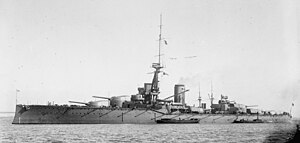 Monarch at anchor, before 1915
| |
| History | |
|---|---|
| Name | Monarch |
| Namesake | A French ship, Monarque, captured in 1747 |
| Builder | Armstrong Whitworth, Elswick |
| Laid down | 1 April 1910 |
| Launched | 30 March 1911 |
| Commissioned | 27 April 1912 |
| Decommissioned | 5 May 1922 |
| Out of service | October 1923 |
| Fate | Sunk as a target, 21 January 1925 |
| General characteristics (as built) | |
| Class and type | Orion-class dreadnought battleship |
| Displacement | 21,922 long tons (22,274 t) (normal) |
| Length | 581 ft (177.1 m) (o/a) |
| Beam | 88 ft 6 in (27.0 m) |
| Draught | 31 ft 3 in (9.5 m) |
| Installed power |
|
| Propulsion | 4 × shafts; 2 × steam turbine sets |
| Speed | 21 knots (39 km/h; 24 mph) |
| Range | 6,730 nmi (12,460 km; 7,740 mi) at 10 knots (19 km/h; 12 mph) |
| Complement | 738–750 (1914) |
| Armament |
|
| Armour | |
HMS Monarch was the second of four Orion-class dreadnought battleships built for the Royal Navy in the early 1910s. She spent the bulk of her career assigned to the Home and Grand Fleets. Aside from participating in the failed attempt to intercept the German ships that had bombarded Scarborough, Hartlepool and Whitby in late 1914, the Battle of Jutland in May 1916 and the inconclusive action of 19 August, her service during World War I generally consisted of routine patrols and training in the North Sea.
After the Grand Fleet was dissolved in early 1919, Monarch was transferred back to the Home Fleet for a few months before she was assigned to the Reserve Fleet. The ship was listed for disposal in mid-1922, but was hulked for use as a stationary training ship. In late 1923 Monarch was converted into a target ship and sunk in early 1925.